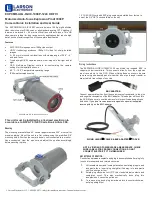
262
THE HASSELBLAD MANUAL
for this loss of light when taking a meter reading with a separate exposure meter. With a
metering system in the camera or a meter prism fi nder, whatever the built-in meter shows is
correct. The aperture on a meter prism fi nder is set for the maximum aperture of the lens as
usual.
PROTECTING YOUR LENSES
Lenses are expensive components of all Hasselblad camera systems. It therefore makes good
sense to keep them clean and in perfect operating condition. Protect them as much as possi-
ble, on and off the camera, with covers whenever they are not used.
This applies especially to the rear of the lens when the lens is off the camera, as it is
often more diffi cult to clean. Protecting the rear of the lens is also recommended to maintain
the proper functioning of the connecting mechanism.
If cleaning the lens surfaces seems to be desirable, always start by blowing off any pos-
sible dust and dirt to prevent scratches on the lens surface. Do any further cleaning only if
deemed necessary. To do so, wipe the surfaces gently with a clean chamois or eyeglass or
lens-cleaning tissue, breathing on the surface if necessary. Lens-cleaning fl uid can be used, but
never put the fl uid directly on the lens. Instead, put it on the cleaning cloth or tissue. Do not
over clean lenses. A little dust does not affect image quality, but fi ngerprints do. Never touch
lens surfaces with your fi ngers. Never touch the electronic contacts on Fe, CFE, and the HC
lenses with your fi ngers.
THE CREATIVE PART THAT HELPS YOU PRODUCE BETTER PHOTOGRAPHS
Since lenses are the main element in determining how the image is recorded on the digital
sensor or on fi lm you must carefully and thoroughly decide which focal length produces the
desired composition and records the elements within the composition in the most effective
fashion. Then you must decide which aperture setting produces the correct exposure and
also records the elements from foreground to background in the desired fashion. In addition
you also have chances to record images in a very special fashion or add special effects to an
otherwise ordinary image. Lenses can be major tools for creating effective, beautiful, unusual,
and interesting images.
LENSES FOR AREA COVERAGE
Wide angle lenses, with their larger angle of view, cover larger areas and record subjects
smaller than the standard lenses. Telephoto lenses have a smaller angle of view, and they
cover smaller areas and make subjects appear larger. Using various focal length lenses, or focal
length settings on a zoom lens, for nothing more than covering a specifi c area is a good rea-
son for selecting wide angle, standard, or tele lenses or using zoom lenses at different focal
length settings. However, before you make the fi nal decision and before you press the release,
try to remember that you can often cover the same selected area with different focal length
Summary of Contents for Digital Camera
Page 1: ......
Page 2: ...The Hasselblad Manual ...
Page 3: ...This page intentionally left blank ...
Page 13: ...This page intentionally left blank ...
Page 166: ...Heidi Niemala Photographed for clothing designer with a 150mm lens ...
Page 167: ...Heidi Niemala Editorial portrait with a 150mm lens ...
Page 168: ...Heidi Niemala Photographed with a 50mm lens during a sand storm at White Sands ...
Page 200: ...Jonathan Exley Lifestyle Designer Kathy Ireland Courtesy of kathyireland com ...
Page 244: ...Marco Grob A make up test shot made with an HC Macro 4 120mm lens on an H camera ...
Page 398: ...Close Up Photography on Film or Digital 383 ...
Page 400: ...Jonathan Singer ...
Page 401: ...Jonathan Singer ...
Page 421: ...This page intentionally left blank ...
















































